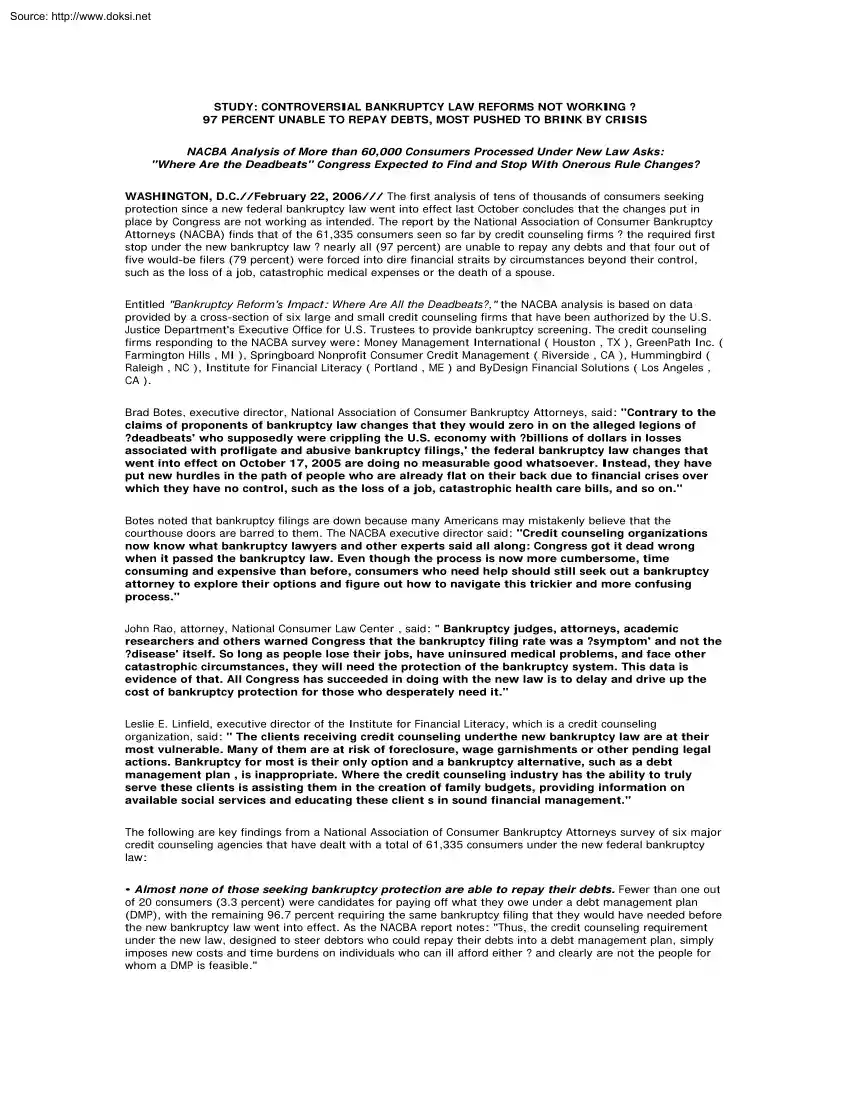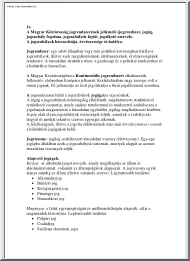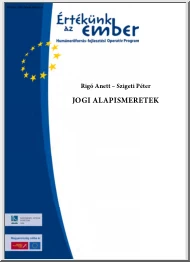Datasheet
Year, pagecount:2006, 2 page(s)
Language:English
Downloads:2
Uploaded:October 01, 2020
Size:462 KB
Institution:
-
Comments:
Attachment:-
Download in PDF:Please log in!
Comments
No comments yet. You can be the first!Most popular documents in this category
Content extract
Source: http://www.doksinet STUDY: CONTROVERSIAL BANKRUPTCY LAW REFORMS NOT WORKING ? 97 PERCENT UNABLE TO REPAY DEBTS, MOST PUSHED TO BRINK BY CRISIS NACBA Analysis of More than 60,000 Consumers Processed Under New Law Asks: "Where Are the Deadbeats" Congress Expected to Find and Stop With Onerous Rule Changes? WASHINGTON, D.C//February 22, 2006/// The first analysis of tens of thousands of consumers seeking protection since a new federal bankruptcy law went into effect last October concludes that the changes put in place by Congress are not working as intended. The report by the National Association of Consumer Bankruptcy Attorneys (NACBA) finds that of the 61,335 consumers seen so far by credit counseling firms ? the required first stop under the new bankruptcy law ? nearly all (97 percent) are unable to repay any debts and that four out of five would-be filers (79 percent) were forced into dire financial straits by circumstances beyond their control, such as the loss of
a job, catastrophic medical expenses or the death of a spouse. Entitled "Bankruptcy Reforms Impact: Where Are All the Deadbeats?," the NACBA analysis is based on data provided by a cross-section of six large and small credit counseling firms that have been authorized by the U.S Justice Departments Executive Office for U.S Trustees to provide bankruptcy screening The credit counseling firms responding to the NACBA survey were: Money Management International ( Houston , TX ), GreenPath Inc. ( Farmington Hills , MI ), Springboard Nonprofit Consumer Credit Management ( Riverside , CA ), Hummingbird ( Raleigh , NC ), Institute for Financial Literacy ( Portland , ME ) and ByDesign Financial Solutions ( Los Angeles , CA ). Brad Botes, executive director, National Association of Consumer Bankruptcy Attorneys, said: "Contrary to the claims of proponents of bankruptcy law changes that they would zero in on the alleged legions of ?deadbeats who supposedly were crippling the U.S
economy with ?billions of dollars in losses associated with profligate and abusive bankruptcy filings, the federal bankruptcy law changes that went into effect on October 17, 2005 are doing no measurable good whatsoever. Instead, they have put new hurdles in the path of people who are already flat on their back due to financial crises over which they have no control, such as the loss of a job, catastrophic health care bills, and so on." Botes noted that bankruptcy filings are down because many Americans may mistakenly believe that the courthouse doors are barred to them. The NACBA executive director said: "Credit counseling organizations now know what bankruptcy lawyers and other experts said all along: Congress got it dead wrong when it passed the bankruptcy law. Even though the process is now more cumbersome, time consuming and expensive than before, consumers who need help should still seek out a bankruptcy attorney to explore their options and figure out how to navigate
this trickier and more confusing process." John Rao, attorney, National Consumer Law Center , said: " Bankruptcy judges, attorneys, academic researchers and others warned Congress that the bankruptcy filing rate was a ?symptom and not the ?disease itself. So long as people lose their jobs, have uninsured medical problems, and face other catastrophic circumstances, they will need the protection of the bankruptcy system. This data is evidence of that. All Congress has succeeded in doing with the new law is to delay and drive up the cost of bankruptcy protection for those who desperately need it." Leslie E. Linfield, executive director of the Institute for Financial Literacy, which is a credit counseling organization, said: " The clients receiving credit counseling underthe new bankruptcy law are at their most vulnerable. Many of them are at risk of foreclosure, wage garnishments or other pending legal actions. Bankruptcy for most is their only option and a bankruptcy
alternative, such as a debt management plan , is inappropriate. Where the credit counseling industry has the ability to truly serve these clients is assisting them in the creation of family budgets, providing information on available social services and educating these client s in sound financial management." The following are key findings from a National Association of Consumer Bankruptcy Attorneys survey of six major credit counseling agencies that have dealt with a total of 61,335 consumers under the new federal bankruptcy law: • Almost none of those seeking bankruptcy protection are able to repay their debts. Fewer than one out of 20 consumers (3.3 percent) were candidates for paying off what they owe under a debt management plan (DMP), with the remaining 96.7 percent requiring the same bankruptcy filing that they would have needed before the new bankruptcy law went into effect. As the NACBA report notes: "Thus, the credit counseling requirement under the new law,
designed to steer debtors who could repay their debts into a debt management plan, simply imposes new costs and time burdens on individuals who can ill afford either ? and clearly are not the people for whom a DMP is feasible." Source: http://www.doksinet • The vast majority of Americans seeking bankruptcy protection are victims of unfortunate circumstances, not reckless spenders seeking to shirk their debts. Four out of five consumers (79 percent) seen by credit counseling agencies are suffering from debt "caused by circumstances beyond their control (e.g, loss of a job, medical expenses, death, divorce or other change in marital status, increased minimum payments on credit cards, predatory lending, and so on). As the NACBA report concludes: "Thus, the masses of expected deadbeats who were supposed to be identified under the new law and forced into debt management plans have not materialized." Only about one in five of the respondents (21 percent) were
identified as suffering from debt due to "circumstances within their control". Credit counseling agency respondents explain that this number includes all of those who did not deliberately seek out to get in over their heads financially but did not fully understand how fees and finance charges associated with credit cards put them deeper and deeper into a hole from which they could not escape, except through bankruptcy. Credit counseling firms ranged in size from small (with 100 consumers seen) to quite large (with nearly 23,000 consumers seen). The end date for the consumer-based information provided by the credit counseling firms ranged from January 31, 2006 to the first two weeks of February 2006. The highest estimate of consumers being able to make repayments under a credit counseling DMP was 5 percent, with the low being in the 1-2 percent range. Estimates of the number of Americans seeking help for financial circumstances beyond their control ranged from a high of 95
percent to a low of 65 percent. Of those believed to be seeking protection for financial problems within their own control, the range was from a high of 35 percent to a low of 5 percent. The NACBA report contrasts the pre-passage comments of opponents of the legislation, who warned that the bankruptcy law changes would not work, and proponents who argued that the new hurdles in the law would slow down or stop abusers of the bankruptcy system. The report quotes House Judiciary Committee Chairman F James Sensenbrenner, Jr. (R-Wis) as predicting the bill would stop "billions of dollars in losses associated with profligate and abusive bankruptcy filings. Senator Charles Grassley (R-Iowa) said the bankruptcy changes would clean up "a convenient financial planning tool where deadbeats can get out of paying their debt scott-free ?"
a job, catastrophic medical expenses or the death of a spouse. Entitled "Bankruptcy Reforms Impact: Where Are All the Deadbeats?," the NACBA analysis is based on data provided by a cross-section of six large and small credit counseling firms that have been authorized by the U.S Justice Departments Executive Office for U.S Trustees to provide bankruptcy screening The credit counseling firms responding to the NACBA survey were: Money Management International ( Houston , TX ), GreenPath Inc. ( Farmington Hills , MI ), Springboard Nonprofit Consumer Credit Management ( Riverside , CA ), Hummingbird ( Raleigh , NC ), Institute for Financial Literacy ( Portland , ME ) and ByDesign Financial Solutions ( Los Angeles , CA ). Brad Botes, executive director, National Association of Consumer Bankruptcy Attorneys, said: "Contrary to the claims of proponents of bankruptcy law changes that they would zero in on the alleged legions of ?deadbeats who supposedly were crippling the U.S
economy with ?billions of dollars in losses associated with profligate and abusive bankruptcy filings, the federal bankruptcy law changes that went into effect on October 17, 2005 are doing no measurable good whatsoever. Instead, they have put new hurdles in the path of people who are already flat on their back due to financial crises over which they have no control, such as the loss of a job, catastrophic health care bills, and so on." Botes noted that bankruptcy filings are down because many Americans may mistakenly believe that the courthouse doors are barred to them. The NACBA executive director said: "Credit counseling organizations now know what bankruptcy lawyers and other experts said all along: Congress got it dead wrong when it passed the bankruptcy law. Even though the process is now more cumbersome, time consuming and expensive than before, consumers who need help should still seek out a bankruptcy attorney to explore their options and figure out how to navigate
this trickier and more confusing process." John Rao, attorney, National Consumer Law Center , said: " Bankruptcy judges, attorneys, academic researchers and others warned Congress that the bankruptcy filing rate was a ?symptom and not the ?disease itself. So long as people lose their jobs, have uninsured medical problems, and face other catastrophic circumstances, they will need the protection of the bankruptcy system. This data is evidence of that. All Congress has succeeded in doing with the new law is to delay and drive up the cost of bankruptcy protection for those who desperately need it." Leslie E. Linfield, executive director of the Institute for Financial Literacy, which is a credit counseling organization, said: " The clients receiving credit counseling underthe new bankruptcy law are at their most vulnerable. Many of them are at risk of foreclosure, wage garnishments or other pending legal actions. Bankruptcy for most is their only option and a bankruptcy
alternative, such as a debt management plan , is inappropriate. Where the credit counseling industry has the ability to truly serve these clients is assisting them in the creation of family budgets, providing information on available social services and educating these client s in sound financial management." The following are key findings from a National Association of Consumer Bankruptcy Attorneys survey of six major credit counseling agencies that have dealt with a total of 61,335 consumers under the new federal bankruptcy law: • Almost none of those seeking bankruptcy protection are able to repay their debts. Fewer than one out of 20 consumers (3.3 percent) were candidates for paying off what they owe under a debt management plan (DMP), with the remaining 96.7 percent requiring the same bankruptcy filing that they would have needed before the new bankruptcy law went into effect. As the NACBA report notes: "Thus, the credit counseling requirement under the new law,
designed to steer debtors who could repay their debts into a debt management plan, simply imposes new costs and time burdens on individuals who can ill afford either ? and clearly are not the people for whom a DMP is feasible." Source: http://www.doksinet • The vast majority of Americans seeking bankruptcy protection are victims of unfortunate circumstances, not reckless spenders seeking to shirk their debts. Four out of five consumers (79 percent) seen by credit counseling agencies are suffering from debt "caused by circumstances beyond their control (e.g, loss of a job, medical expenses, death, divorce or other change in marital status, increased minimum payments on credit cards, predatory lending, and so on). As the NACBA report concludes: "Thus, the masses of expected deadbeats who were supposed to be identified under the new law and forced into debt management plans have not materialized." Only about one in five of the respondents (21 percent) were
identified as suffering from debt due to "circumstances within their control". Credit counseling agency respondents explain that this number includes all of those who did not deliberately seek out to get in over their heads financially but did not fully understand how fees and finance charges associated with credit cards put them deeper and deeper into a hole from which they could not escape, except through bankruptcy. Credit counseling firms ranged in size from small (with 100 consumers seen) to quite large (with nearly 23,000 consumers seen). The end date for the consumer-based information provided by the credit counseling firms ranged from January 31, 2006 to the first two weeks of February 2006. The highest estimate of consumers being able to make repayments under a credit counseling DMP was 5 percent, with the low being in the 1-2 percent range. Estimates of the number of Americans seeking help for financial circumstances beyond their control ranged from a high of 95
percent to a low of 65 percent. Of those believed to be seeking protection for financial problems within their own control, the range was from a high of 35 percent to a low of 5 percent. The NACBA report contrasts the pre-passage comments of opponents of the legislation, who warned that the bankruptcy law changes would not work, and proponents who argued that the new hurdles in the law would slow down or stop abusers of the bankruptcy system. The report quotes House Judiciary Committee Chairman F James Sensenbrenner, Jr. (R-Wis) as predicting the bill would stop "billions of dollars in losses associated with profligate and abusive bankruptcy filings. Senator Charles Grassley (R-Iowa) said the bankruptcy changes would clean up "a convenient financial planning tool where deadbeats can get out of paying their debt scott-free ?"





 Just like you draw up a plan when you’re going to war, building a house, or even going on vacation, you need to draw up a plan for your business. This tutorial will help you to clearly see where you are and make it possible to understand where you’re going.
Just like you draw up a plan when you’re going to war, building a house, or even going on vacation, you need to draw up a plan for your business. This tutorial will help you to clearly see where you are and make it possible to understand where you’re going.